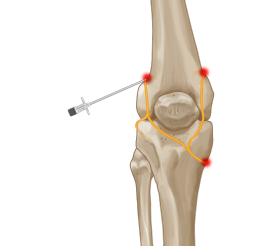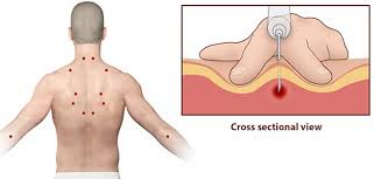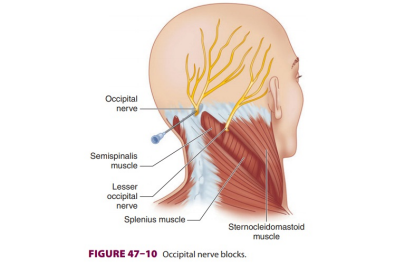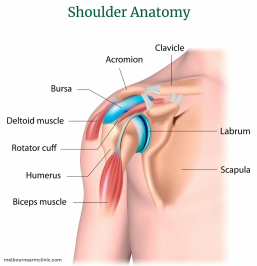Genicular Nerve Block
The Genicular nerves transmit pain signals from the knee that are caused by Osteoarthritis. By injecting a mixture of anesthetic and steroid around the nerves, we can “calm down” the nerves so they don’t transmit as many pain signals. People will often have 2-4 months of improvement in their pain and level of function, although occasionally some people have no improvement. These nerve blocks are associated with minimal side effects and can be repeated as needed.
The goal of these procedures is to control your pain so that you can have improved mobility/ability to exercise. This is extremely important for the long-term management of your pain and quality of life.
It is important to understand that optimal management of chronic knee pain involves multiple modalities, including:
- Exercise (refer to exercise plan hand out)
- Physical Therapy (Physio, massage etc.)
- Weight Loss (Canada’s Food Guide)
- Knee Brace
- Medications (oral and topical)
- Supplements (uncertain benefits)
- Mental wellness
- Spirituality

Trigger Point Injections
Trigger point injections are used to treat muscular and fascial pain. Fascia is a fibrous tissue that covers muscles and is rich in nerves. Abnormally shortened muscle fibers and fascia are the result of a dysfunctional nervous system and contribute to pain in numerous medical conditions.
Sterile medical needles are inserted into the muscle/fascia and a small amount of Lidocaine is injected. This can help relax these shortened muscle fibers and fascia, thereby relieving pain and restoring normal function.
Depending on the severity of your condition, it can take a number of treatments to improve or resolve your symptoms. On average, 5-10 treatments are needed, however some patients do benefit from ongoing treatment.
The goal of these procedures is to control your pain so that you can have improved mobility/ability to exercise. This is extremely important for the long-term management of your pain and quality of life.
It is important to understand that optimal management of chronic pain involves multiple modalities, including:
- Exercise and lifestyle (sleep, stress management)
- Weight Loss (Canada’s Food Guide)
- Psychological / Mental wellness (counseling, mindfulness, support groups) • Physical Therapy (Physio, massage etc.)
- Medications (oral and topical)
- Spirituality (meditation, connecting to nature, religion)

Occipital Nerve Block
The occipital nerves arise from the base of the skull and transmit sensory information from the scalp. These nerves are often a source of chronic headaches when they are malfunctioning. They can also become irritated and cause pain in the scalp directly, something called occipital neuralgia.
By injecting a mixture of anesthetic and/or steroid around the nerves, we can “calm down” the nerves so they don’t transmit as many pain signals. This can often lead to relief of headaches for months at a time.
It is important to understand that optimal management of chronic pain involves multiple modalities, including:
- Exercise and lifestyle (sleep, stress management)
- Weight Loss (Canada’s Food Guide)
- Psychological / Mental wellness (counseling, mindfulness, support groups) • Physical Therapy (Physio, massage etc.)
- Medications (oral and topical)
- Spirituality (meditation, connecting to nature, religion)

Sacroiliac (SI) Joint Injection
The SI joint connects the hip bone (ilium) to the sacrum (lowest part of the spine). This joint can become inflamed which can lead to pain in the lower back and buttocks. Inflammation can be caused by arthritis, improper biomechanics, trauma or infection.
Injecting a combination of anesthetic and steroid medication can reduce inflammation in the SI joint and provide effective long lasting pain relief.
The goal of these procedures is to control your pain so that you can have improved mobility/ability to exercise. This is extremely important for the long-term management of your pain and quality of life.
It is important to understand that optimal management of chronic pain involves multiple modalities, including:
- Exercise and lifestyle (sleep, stress management)
- Weight Loss (Canada’s Food Guide)
- Psychological / Mental wellness (counseling, mindfulness, support groups) • Physical Therapy (Physio, massage etc.)
- Medications (oral and topical)
- Spirituality (meditation, connecting to nature, religion)

Subacromial Bursa Injection (Shoulder Injection)
A bursa is a thin fluid filled sac wedged between bone and muscles or soft tissue. Its purpose is to reduce friction between the bone and the muscle/tendon that moves over it. Bursae can become inflamed for a variety of reasons such as overuse of a joint, muscle tears or trauma. The subacromial bursa lies within the shoulder and will often become inflamed leading to significant pain and loss of function of the joint.
Injecting a combination of anesthetic and steroid medication can reduce inflammation in the subacromial bursa and provide effective long lasting pain relief.
The goal of these procedures is to control your pain so that you can have improved mobility/ability to exercise. This is extremely important for the long-term management of your pain and quality of life.
It is important to understand that optimal management of chronic pain involves multiple modalities, including:
- Exercise and lifestyle (sleep, stress management)
- Weight Loss (Canada’s Food Guide)
- Psychological / Mental wellness (counseling, mindfulness, support groups) • Physical Therapy (Physio, massage etc.)
- Medications (oral and topical)
- Spirituality (meditation, connecting to nature, religion)

Biceps Tendon Sheath Injection
The biceps muscle has 2 parts, with separate tendinous origins within the shoulder. The “long head” tendon lies in a groove on the upper arm bone (Humerus). This tendon can become inflamed for a variety of reasons such as overuse of a joint, muscle tears or trauma, leading to significant pain and loss of function of the joint.
Injecting a combination of anesthetic and steroid medication around the biceps tendon can reduce inflammation and provide effective long lasting pain relief.
The goal of these procedures is to control your pain so that you can have improved mobility/ability to exercise. This is extremely important for the long-term management of your pain and quality of life.
It is important to understand that optimal management of chronic pain involves multiple modalities, including:
- Exercise and lifestyle (sleep, stress management)
- Weight Loss (Canada’s Food Guide)
- Psychological / Mental wellness (counseling, mindfulness, support groups) • Physical Therapy (Physio, massage etc.)
- Medications (oral and topical)
- Spirituality (meditation, connecting to nature, religion)
